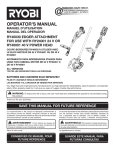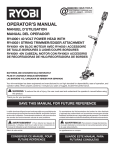Download A&D AD-4212C-3000 Instruction manual
Transcript
AD-8923-CC Remote Controller (CC-Link) INSTRUCTION MANUAL 1WMPD4002124 © 2010 A&D Company, Limited. All rights reserved. No part of this publication may be reproduced, transmitted, transcribed, or translated into any language in any form by any means without the written permission of A&D Company, Limited. The contents of this manual and the specifications of the instrument covered by this manual are subject to change for improvement without notice. . CONTENTS 1. INTRODUCTION ...........................................................................................................2 1.1. Features ..................................................................................................................2 2. DESCRIPTION OF EACH PART ..................................................................................3 2.1. Display ....................................................................................................................4 2.2. Keys ........................................................................................................................4 2.3. Connectors ..............................................................................................................4 3. CONNECTION ..............................................................................................................5 3.1. 3.2. 3.3. 3.4. 3.5. Setting the AD-4212C and the AD-8923-CC ...........................................................5 Connecting the cables.............................................................................................5 Turning the power on...............................................................................................6 Operation ................................................................................................................9 Calibrating the AD-4212C........................................................................................9 4. FUNCTION SETTING ................................................................................................. 11 4.1. Display and keys ...................................................................................................12 4.2. Function table........................................................................................................12 4.3. Initializing the AD-8923-CC ...................................................................................13 5. RS-232C CONNECTOR..............................................................................................14 5.1. RS-232C serial interface specifications.................................................................14 6. CC-Link CONNECTOR...............................................................................................15 6.1. CC-Link interface specifications ............................................................................15 6.2. Timing chart...........................................................................................................20 6.3. Fixing the decimal point position ...........................................................................22 7. TROUBLESHOOTING ................................................................................................23 8. SPECIFICATIONS.......................................................................................................24 9. EXTERNAL DIMENSIONS..........................................................................................24 1 1. INTRODUCTION This manual describes how the AD-8923-CC remote controller works and how to get the most out of it in terms of performance. Read this manual thoroughly before using the AD-8923-CC and keep it at hand for future reference. 1.1. Features Connecting the AD-8923-CC remote controller and the AD-4212C series production weighing unit will enable transmission of the weight data to a PLC using CC-Link. z Displays the weight data transmitted from the AD-4212C. z Can change the weighing speed of the AD-4212C, calibrate the AD-4212C using an external calibration weight and share the power supply with the AD-4212C. Note When the AD-4212C is used as the weighing instrument, connecting power to either the AD-8923-CC or the AD-4212C will supply power to both devices. Refer to “3.3. Turning the power on.” z Using the CC-Link interface, one CC-Link master station can control up to 42 units consisting of an AD-8923-CC and AD-4212C, to receive data or perform re-zeroing. Note CC-Link is a high-speed field network able to simultaneously handle both control and information data. With a high communication speed of 10 Mbps, CC-Link can achieve the maximum transmission distance of 100 meters and connect to 64 stations. When a CC-Link network is configured using the AD-8923-CC, the maximum number of stations (or units) will be 42. 2 2. DESCRIPTION OF EACH PART Display AC adapter input jack DC input terminal CC-Link connector Keys Accessories FG terminal CC-Link plug 1 pc. RS-232C connector (D-Sub 9-pin) See the note below. Rear View Connector operation lever 1 pc. Note AC adapter 1 pc. When the AD-8923-CC is to be built into a weighing system, be sure to ground the FG terminal. Please confirm that the AC adapter type is correct for your local voltage and receptacle type. AD adapter ID label 3 2.1. Display REMOTE CONTROLLER AD-8923 Turns on while the AD-4212C is in the standby mode. RESPONSE STABLE FAST MID. CAL SAMPLE PRINT MODE RE-ZERO SLOW Weighing speed indicators STABLE indicator ON:OFF Unit indicator z Displays the weight data received. When the unit is “g” (gram), the unit indicator turns on. z When the weight value is stable (the header of the weight data received is “ST”), the STABLE indicator turns on. z If the AD-8923-CC does not receive the weight data for two seconds or more, - - - - - is displayed (Bar display). z Displays the AD-4212C weighing speed that is currently set, by turning on the corresponding indicator. 2.2. Keys z Operates the AD-4212C. For details, refer to “3.4. Operation”. z To enter the function setting of the AD-8923-CC, press the CAL key while holding down the ON:OFF key. For details, refer to “4. FUNCTION SETTING”.) 2.3. Connectors z RS-232C connector ...... D-Sub 9-pin (male) Used to connect to the AD-4212C weighing unit. For details, refer to “5. RS-232C CONNECTOR”. z CC-Link connector ........ 5-pin (male) Used to connect to other AD-8923-CCs, PLCs or other CC-Link devices. For details, refer to “6. CC-Link CONNECTOR”. z DC input terminal (24 DCV) / AC adapter input jack Either power supply can be used. For details, refer to “3.3. Turing the power on”. 4 3. CONNECTION 3.1. Setting the AD-4212C and the AD-8923-CC Set the following items so that the AD-4212C and the AD-8923-CC have the same value for each item. Item AD-4212C AD-8923-CC Baud rate 600, 1200, 2400*, 4800, 9600, 19200 bps Data bits, parity 7 bits EVEN* Stop bits 1 bit* Terminator <CR><LF>* Data format A&D standard format − Communication control No RTS/CTS control − Data output mode Stream mode − * Factory setting for the AD-8923-CC. The factory setting for the AD-4212C is the same unless otherwise specified. 3.2. Connecting the cables Connect the cables using the connectors located on the rear of the AD-8923-CC. Connection example to the AD-4212C and a PLC RS-232C connector (D-Sub 9-pin) AD-8923-CC CC-Link connector (5-pin) Connect to the power supply Refer to “3.3. Turning the power on”. Ground Ground CC-Link network PLC (CC-Link master station) AD-4212C CC-Link network RS-232C cable provided with the D-4212C To other remote stations such as the AD-8923-CC. Note Be sure to ground the AD-4212C and the AD-8923-CC. 5 Connection example to the CC-Link network (weighing instruments No.1 through No.4) Connect a terminating resistor only to the stations at each end of the network. CC-Link master station (Ground) Weighing instrument AD-8923-CC AD-8923-CC AD-8923-CC AD-8923-CC AD-4212C AD-4212C AD-4212C AD-4212C No.3 No.4 No.1 No.2 z The value of the terminating resistor varies depending on the CC-Link cable used. z Use the same resistor at each end of the network. Cable FANC-SB Terminating resistor FANC-110SBH 110Ω 1/2 W FANC-SBH 130Ω 1/2 W Terminating resistors are not provided. 3.3. Turning the power on As a power supply, an external 24-VDC power supply (24 VDC±10% / 700mA) or a 12-VDC AC adapter can be used. Note When the AD-4212C is used, connecting power to either the AD-8923-CC or the AD-4212C will supply power to both devices. So, instead of the AD-8923-CC, using the AC adapter on the AD-4212C will supply power to the AD-8923-CC. If the power is connected to both, no problems occur because the power to be used is selected automatically. 6 When the external 24-VDC power supply is used Connect an external 24-VDC power supply to the DC input terminal located on the rear of the AD-8923-CC. Precautions on using the external power supply CAUTION z Use a power supply within the rated voltage range (24 VDC±10%). Never use a power supply with a voltage exceeding the rated range. • It may cause damage or heat buildup. • The AD-8923-CC may not function properly. z Ground the FG terminal of the switching power supply used. • To avoid electrical shock and increase the system safety. • To increase the resistance against noises. z Do not share the power line with other devices. • Strong noises introduced from other devices may cause damage to the AD-8923-CC. • Inrush current from other devices may cause the AD-8923-CC not to start up properly. • Circuit configuration of the AD-8923-CC may affect other devices to prevent them from functioning properly. z Select a switching power supply with a capacity of approximately 700mA for each AD-8923-CC. Note that the AD-8923-CC may not start up with a capacity less than 700mA. • If the power supply capacity is not sufficient, the AD-8923-CC may not function properly. z Be sure to add a noise filter on the front end of the switching power supply and ground the FG terminal. • This will increase the resistance against noises. z Be sure to ground the FG terminal of the AD-8923-CC and the AD-4212C. • This will increase the resistance against noises. 7 Cable connection CAUTION Before inserting the power line, make sure that the power to the AD-8923-CC is turned off. DC input terminal (1) Inserting the power line Press down the release button on the DC input terminal using a screwdriver and insert the power line. The recommended stripping length for the power line is 10 mm. AD-8923-CC rear Power line Release button Screwdriver Applicable wire range • Single wire: φ1.0 mm (AWG 26) to φ1.2 mm (AWG 16) • Twisted wire: 0.3 mm2 (AWG 22) to 0.75 mm2 (AWG 20) Individual wire diameter φ0.18 mm or greater (2) Securing or removing the power line To secure the power line, return the release button to the initial position using the screwdriver. The power line will be locked. To remove the power line, press the release button again using the screwdriver, unlocking the power line. When the AC adapter is used Insert the AC adapter plug into the AC adapter input jack located on the rear of the AD-8923-CC and insert the AC adapter into an electrical outlet. AC adapter input jack DC input terminal AC adapter plug AD-8923-CC rear 8 3.4. Operation z Displays the data transmitted by the weighing instrument connected. z The AD-8923-CC key functions when connected to a weighing instrument are listed below: (e.g. when the AD-4212C is connected) Model Keys of the AD-8923-CC ON:OFF CAL Switches between the weighing AD-4212C mode and the standby mode. Enters the calibration mode using a weight. SAMPLE Switches the minimum display. PRINT MODE RE-ZERO Used for the function setting mode and calibration mode. Switches the weighing speed. Sets the display to zero. 3.5. Calibrating the AD-4212C The following is the calibration procedure when the AD-4212C is connected. (A calibration weight is used.) Caution z Do not allow vibration, drafts or temperature change to affect the AD-4212C during calibration. Caution on using an external calibration weight z The accuracy of the weight can influence the accuracy of weighing. Select an appropriate weight as listed below. A calibration weight of 200 g (conforming to OIML, Class E2 or equivalent) is provided with the AD-4212C as a standard accessory. Weighing instrument Usable calibration weight AD-4212C-300 50g, 100g, 200 g, 300g AD-4212C-600 50g, 100g, 200 g, 300g, 400 g, 500 g, 600 g AD-4212C-3000 50g, 100g, 200 g, 300g, 400 g, 500 g, 1000 g, 2000g, 3000g AD-4212C-6000 200 g, 500 g, 1000 g, 2000g, 3000g, 4000 g, 5000 g, 6000 g The calibration weight in bold type: factory setting Display z This indicator means “the AD-4212C is measuring calibration data”. Do not allow vibration, drafts or other external disturbances to affect AD-4212C while this indicator is displayed. 9 Calibration procedure Calibrates the AD-4212C using the calibration weight. Operation 1. Warm up the AD-4212C for 30 minutes or more with nothing on the pan. 2. Press the CAL key. Cal 0 is displayed. z If you want to cancel calibration, press the CAL key. The display will return to the weighing mode. z If you want to change the calibration mass value, press the SAMPLE key. Press the RE-ZERO key to select the mass value, and press the PRINT key to store it. Cal 0 is displayed. RESPONSE STABLE FAST MID. SLOW CAL Press RESPONSE MID. SLOW STABLE FAST PRINT Press 3. Confirm that there is nothing on the pan and press the PRINT key. The AD-4212C measures the zero point. Do not allow vibration or drafts to affect the AD-4212C. The calibration weight value is displayed. RESPONSE STABLE FAST MID. SLOW RESPONSE STABLE FAST MID. SLOW Calibration weight 4. Place a calibration weight, of the weight value displayed, on the pan and press the PRINT key. The AD-4212C measures the calibration weight. Do not allow vibration or drafts to affect the AD-4212C. 5. end pan. Press PRINT RESPONSE MID. SLOW STABLE FAST is displayed. Remove the weight from the 6. The display will automatically return to the weighing mode. 7. Place the calibration weight on the pan and confirm that calibration was performed correctly. If not, check the ambient conditions such as drafts or vibration, and repeat steps 2 through 7. 10 RESPONSE STABLE FAST MID. SLOW RESPONSE STABLE FAST MID. SLOW 4. FUNCTION SETTING Function setting specifies the AD-8923-CC performance. The parameters are stored in non-volatile memory, and are maintained even if the power line or AC adapter is removed. The function setting menu consists of two layers. The first layer is the “Class” and the second layer is the “Item”. Each item stores a parameter. Press the SAMPLE key to select an item and press the RE-ZERO key to change the parameter. Then, press the PRINT key to store the new parameter. Example This example sets “Baud rate” to “9600 bps”. START While holding down press Item "Baud rate" Parameter "9600 bps" Press twice Item Class END Note The AD-8923-CC may not function properly, depending on the settings and operating environment. Check the settings and change them as necessary. 11 4.1. Display and keys The STABLE indicator turns on to indicate that the parameter displayed is in effect. Selects a class or item. Changes the parameter. When a class is displayed, moves to an item in the class. When an item is displayed, stores the new parameter and displays the next class. When an item is displayed, cancels the new parameter and displays the next class. When a class is displayed, exits the function setting mode and returns to the weighing mode. 4.2. Function table Class Item and Parameter 0 Disabled Description Displays the decimal point position of the weight data received. Fixes the decimal point at the set digit. Even if the minimum display is switched using the SAMPLE key, the decimal point position does not change. For details, refer to “6.3. Fixed decimal point position.” Disables the SAMPLE key function. 1 Enabled Enables the SAMPLE key function. 0 1 2 3 4 5 1 600 bps 1200 bps 2400 bps 4800 bps 9600 bps 19200 bps Set the same value as that of the weighing instrument to be connected. - fnc Environment Display dpp Decimal point position CCl CC-Link interface 0 Fixed 5 5apl Sample key function 5if Serial interface Not fixed bp5 Baud rate 5tn Station number C-bp CC-Link baud rate 64 0 1 2 3 4 Station number 156 Kbps 625 Kbps Set the same value as that of the 2.5 Mbps CC-Link master station to be connected 5 Mbps 10 Mbps Factory setting 12 4.3. Initializing the AD-8923-CC Initialization restores the function settings of the AD-8923-CC to factory settings. Operation 1 Turn the power on. - - - - - or weighing mode display appears. 2 While holding down the ON:OFF key, press the PRINT key. Clr is displayed. 3 Press the PRINT key. To cancel this operation, press the CAL key 4 Press the RE-ZERO key to select “go”. 5 Press the PRINT key to perform initialization. After initialization, - - - - - or weighing mode display appears. . 13 While holding ON:OFF down Press PRINT Press PRINT Press RE-ZERO Press PRINT 5. RS-232C CONNECTOR The RS-232C cable provided with the AD-4212C can be connected directly. 5.1. RS-232C serial interface specifications RS-232C Transmission system : EIA RS-232C Transmission form : Asynchronous, bi-directional, half duplex Data format : Baud rate : 600, 1200, 2400, 4800, 9600, 19200 bps Data bits : 7 or 8 bits Parity : EVEN, ODD (Data bits 7 bits) NONE (Data bits 8 bits) Stop bits : 1 bit or 2 bits Code : ASCII Terminator: <CR> or <CR><LF> Connection to the weighing instrument D-Sub 9-pin Pin Signal Direction Description No. name (RTS) RXD (DSR) (Vs) SG (CTS) TXD (Va) Circuit AD-8923-CC interior 5 4 9 3 8 2 7 1 6 Inch screw (#4-40UNC) 1 (Vs) − Used internally 2 RXD Input Receive data 3 TXD Output Transmit data 4 − − N.C. 5 SG − Signal ground 6 (DSR) − Used internally 7 (RTS) − Used internally 8 (CTS) − Used internally 9 (Va) − Used internally (The AD-8923-CC is a DTE device. Connect to a DCE device such as the AD-4212C, using a straight through cable.) To the weighing instrument Note When the user prepares a cable, do not connect to the pins that are used internally. 14 6. CC-Link CONNECTOR The AD-8923-CC CC-Link is a remote device station of CC-Link ver.1.10. When a CC-Link is used, the AD-8923-CC can be controlled by the PLC remote I/O or remote registers. So, the program can be simple. And connection to a PLC is simple, thus, a weighing system can be built easily. The setting values of CC-Link are changed in the function setting CCl. 6.1. CC-Link interface specifications Station number 1 to 64 Baud rate 156 kbps, 625 kbps, 2.5 Mbps, 5 Mbps, 10 Mbps Communications connector The connector used can be attached or removed while the power is ON. The function of each signal line is as follows. DA Signal DA DB Signal DB DG Signal ground SLD Shield FG Frame ground Status LEDs LED RUN ON OFF • Resetting • No signal Normal Blinking − SD Transmitting − − RD Receiving − − ERR • Setting error • CRC error • Station trouble Normal CC-Link connector and LEDs 15 When the setting values are changed Memory map Remote register (Number of occupied stations: 1) Blank “Name” column: internally reserved (not used). AD-8923-CC --> Master station Remote register Buffer memory RWr0000 2E0 RWr0001 2E1 RWr0002 2E2 RWr0003 2E3 Master station --> AD-8923-CC Remote register Buffer memory RWw0000 2E0 RWw0001 2E1 Error code RWw0002 2E2 Error sub-code RWw0003 2E3 Name Weight value 16 Name Remote I/O (Number of occupied stations: 1) Blank “Name” column: internally reserved (not used). AD-8923-CC --> Master station Remote Buffer Name memory input Master station --> AD-8923-CC Remote Buffer Name memory output RX0000 RX0001 RX0002 RX0003 RX0004 RX0005 RX0006 RX0007 RX0008 RX0009 RX000A RX000B RX000C RX000D RX000E RX000F RX0010 RX0011 RX0012 RX0013 RX0014 RX0015 RX0016 RX0017 RX0018 RY0000 RY0001 RY0002 RY0003 RY0004 RY0005 RY0006 RY0007 RY0008 RY0009 RY000A RY000B RY000C RY000D RY000E RY000F RY0010 RY0011 RY0012 RY0013 RY0014 RY0015 RY0016 RY0017 RY0018 RX0019 0E0 0E1 CPU operation Stable / Unstable Decimal point 20 Decimal point 21 Decimal point 22 Request flag of initialization Reply flag of initial data setting RY0019 RX001A Error status flag RY001A RX001B RX001C RX001D RX001E RX001F Remote READY flag RY001B RY001C RY001D RY001E RY001F 17 Re-zero Tare (Re-zero) 160 161 Reply flag of initialization Request flag of initial data setting Request flag of error reset Numeric values of the remote register All the values are hexadecimal. Negative values are expressed by the two’s complement. Decimal Hexadecimal (32 bits) -10 FFFFFFF6 -1 FFFFFFFF 0 00000000 1 00000001 10 0000000A Weight value examples 1.000 will be 1000, thus expressed as 0x000003E8. (RWr0001: 0x0000, RWr0000: 0x03E8) -1.000 will be -1000, thus expressed as 0xFFFFFC18. (RWr0001: 0xFFFF, RWr0000: 0xFC18) Prohibited writing in the internally reserved areas Writing is prohibited in the internally reserved areas. Writing in the remote output (RY) and the remote register (RWw) of the internally reserved areas may cause the AD-8923-CC to malfunction. Values of the remote input (RX) and the remote register (RWr) of the internally reserved areas are not fixed. Error code Error code Error status flag (Instrument error) 0 No error 1 - 2 EEPROM error (Writing error) 3 - 4 Calibration error 5 Weighing instrument error 6 RS-232C error 7 Over (+) 8 Over (-) Stable / Unstable RX0007 0 Unstable 1 Stable 18 Decimal point RX0008 to RX000A, 3-bit binary notation RX000A RX0009 RX0008 Decimal point position 0 0 0 No decimal point 0 0 1 First digit 0 1 0 Second digit 0 1 1 Third digit 1 0 0 Fourth digit 1 0 1 Fifth digit Decimal point position example When displaying 1.000, express 3 as a decimal point at the third digit, thus 0x011. (RX000A: 0, RX0009: 1, RX0008: 1) Re-zero / Tare Sets the weighing instrument to zero. When the remote I/O register turns on (1), re-zeroing is performed. 19 6.2. Timing chart Below examples are when the station number is set to 1. When connecting to a power supply When the AD-8923-CC is connected to a power supply and the CC-Link is ready, the request flag of initialization (RX0018) becomes active. The master station confirms that RX0018 is active, performs initialization and turns the reply flag of initialization (RY0018) ON. The AD-8923-CC turns the request flag of initialization (RX0018) OFF and turns the remote READY flag (RX001B) ON. Turn OFF the reply flag of initialization (RY0018) in the master station. When the request flag of initialization (RX0018) is ON, the reply flag of initialization (RY0018) is turned ON. Power Request flag of initialization (RX0018) ON When the request flag of initialization (RX0018) is OFF, the reply flag of initialization (RY0018) is turned OFF. Reply flag of initialization (RY0018) Remote READY flag (RX001B) Performance upon power-ON Resuming from suspended modes When the AD-8923-CC is in a mode that suspends weighing, such as calibration or display-OFF, the remote READY flag (RX001B) becomes inactive because a correct weight value can not be output. To resume from this condition, take the same steps as described in “When connecting to a power supply” above. CPU operation The CPU normal operation (RX0006) is a signal to check that the AD-8923-CC is connected to a power supply and it functions normally. During normal operation, the signal is reversed at an interval of 0.5 to 1 second. CPU normal operation (RX0006) 0.5 to 1 second CPU normal operation signal 20 Requesting initialization from the master station When requesting the initial data setting to the AD-8923-CC from the master station, turn the request flag of initial data setting (RY0019) ON while the remote READY flag (RX001B) is active. The AD-8923-CC turns the remote READY flag (RX001B) OFF and performs initial data settings. When initial data settings are complete, the reply flag of initial data setting (RX0019) is turned ON. Turn OFF the request flag of initial data setting (RY0019) in the master station. When the remote READY flag (RX001B) is ON, the request flag of initial data setting (RY0019) is turned ON. When the reply flag of initial data setting (RX0019) is ON, the request flag of initial data setting (RY0019) is turned OFF. Request flag of initial data setting (RY0019) Remote READY flag (RX001B) Reply flag of initial data setting (RX0019) When the reply flag of initial data setting (RX0019) is OFF, the remote READY flag (RX001B) is turned ON again. Performance of request flag of initial data setting Error status flag When an error occurs to the AD-8923-CC, the remote READY flag (RX001B) becomes inactive and the error status flag (RX001A) becomes active to inform the master station of the error occurrence. The master station requests to reset the error status flag, by activating the request flag of error reset (RY001A). Error status flag (RX001A) Request flag of error reset (RY001A) Remote READY flag (RX001B) Error code (RWr0002) Error sub-code (RWr0003) Error code (RWr0002) and Error sub-code (RWr0003) will be cleared to 0. Resetting the error status flag 21 6.3. Fixing the decimal point position Using the function setting of dpp, the decimal point position of the value displayed on the AD-8923-CC and the decimal point position of the weight value output via CC-Link can be fixed. In this way, even if the minimum display is switched using the SAMPLE key, the digit position for CC-Link output does not change. Example 1: Does not fix the decimal point position(dpp - )Factory setting Key AD-4212C output AD-8923-CC display S T , + 0 0 1 2 3 . 4 5 , g CR LF CC-Link output (Weight value) (Decimal point) 12346 RESPONSE STABLE FAST MID. SLOW Second digit 123456 S T , + 0 1 2 3 . 4 5 6 , g CR LF RESPONSE STABLE FAST MID. SLOW Third digit Note : space 20h When the minimum display is switched using the SAMPLE key, the digits of the weight values output via CC-Link don’t align with each other. Example 2: Fixes the decimal point position to the third digit(dpp 3 ) Key AD-4212C output AD-8923-CC display CC-Link output (Weight value) (Decimal point) 123460 S T , + 0 0 1 2 3 . 4 5 , g CR LF RESPONSE STABLE FAST MID. SLOW Third digit 123456 S T , + 0 1 2 3 . 4 5 6 , g CR LF RESPONSE STABLE FAST MID. SLOW Third digit Note : space 20h Even if the minimum display is switched using the SAMPLE key, the digits of the weight values output via CC-Link align with each other. 22 7. TROUBLESHOOTING Symptom eerror 10 appears. (Bar display) remains and the weight value is not displayed. ------ Description Communication settings of the AD-8923-CC do not match with those of the weighing instrument. Check the settings such as baud rate and parity and correct them as necessary. For details, refer to “3.1. Setting the AD-4212C and the AD-8923-CC”. • Is the data output mode of the weighing instrument set to “stream mode”? In a mode other than “stream mode”, the weight values are displayed only when they are transmitted. • Check if the communication settings are correct. • Check if the cables are the correct type and are not damaged. Electrical noise may cause this symptom. The display flickers. Ground the FG terminal located on the rear of the AD-8923-CC. 23 8. SPECIFICATIONS Power supply : External 24-VDC power supply (24 VDC±10% / 700mA) or AC adapter (Output: 12 VDC / 300mA) Please confirm that the AC adapter type is correct for your local voltage and receptacle type. Transmission system : RS-232C, CC-Link (CC-Link ver.1.10 remote device station) Communications connector : D-Sub 9-pin (male) (RS-232C connector to the weighing instrument) 5-pin (male) (CC-Link connector) External dimensions : 144 (W) X 110 (D) X 72 (H) mm Mass : Approx. 1.0 kg Standard accessories : CC-Link plug 1 pc. Connector operation lever 1 pc. 9. EXTERNAL DIMENSIONS 67 10 (116) 110 100 144 144 138 +10 SAMPLE PRINT RESPONSE STABLE FAST MID. CAL 72 ON:OFF 68 +0.7 0 REMOTE CONTROLLER AD-8923 Panel cutout dimensions SLOW MODE RE-ZERO Panel cutout dimensions when panel mounted Unit: mm 24 3-23-14 Higashi-Ikebukuro, Toshima-ku, Tokyo 170-0013 JAPAN Telephone: [81] (3) 5391-6132 Fax: [81] (3) 5391-6148 A&D ENGINEERING, INC. 1756 Automation Parkway, San Jose, California 95131 U.S.A. Telephone: [1] (408) 263-5333 Fax: [1] (408)263-0119 A&D INSTRUMENTS LIMITED <UK Office> Unit 24/26 Blacklands Way, Abingdon Business Park, Abingdon, Oxfordshire OX14 1DY United Kingdom Telephone: [44] (1235) 550420 Fax: [44] (1235) 550485 A&D INSTRUMENTS LIMITED <German Sales Office> Große Straße 13 b 22926 Ahrensburg Deutschland Telefon: [49] (0) 4102 459230 Telefax: [49] (0) 4102 459231 A&D Australasia Pty Ltd. 32 Dew Street, Thebarton, South Australia 5031 AUSTRALIA Telephone: [61] (8) 8301-8100 Fax: [61] (8) 8352-7409 A&D KOREA Limited 한국에이.엔.디(주) 대한민국 서울시 영등포구 여의도동 36-2 맨하탄 빌딩 8층 ( 8th Floor, Manhattan Bldg. 36-2 Yoido-dong, Youngdeungpo-ku, Seoul, KOREA ) 전화: [82] (2) 780-4101 팩스: [82] (2) 782-4280 A&D RUS CO., LTD. Компания ЭЙ энд ДИ РУС 121357, Российская Федерация, г.Москва, ул. Верейская, дом 17 ( Bldg. 17, Vereyskaya st., Moscow, 121357 RUSSIAN FEDERATION ) тел.: [7] (495) 937-33-44 факс: [7] (495) 937-55-66 A&D Instruments India Private Limited ( 509, Udyog Vihar, Phase- , Gurgaon - 122 016, Haryana, India ) : 91-124-4715555 : 91-124-4715599





































